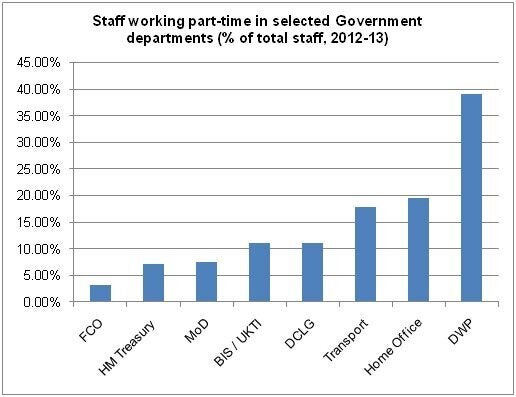The Government's response to its own Modern Workplaces Consultation announced that the civil service would become an "exemplar in flexible working practices". This is a good thing. Flexible working is beneficial for individual wellbeing, for families, and for businesses. Government is right to set a good example. But a series of parliamentary questions which I recently submitted, asking for precise details of flexible working practices in government, revealed a muddled picture of inconsistency across departments, both in the number of staff working flexibly, and in the way these details are recorded.
All departments recorded the number of staff working for them part-time (see below).

Other information was less easy to come by. For example, numbers of staff in a job-share were mostly withheld because recording such information would incur "disproportionate cost", the answers said. Some departments seemed not to worry about the cost; the Foreign and Commonwealth Office and the Ministry of Justice revealed that 0.7% and 0.2% of their staff respectively were in a job-share. The Welsh Office had no staff working in a job-share, and all other departments failed to record how many were, if any.
The proportion of staff working in other flexible arrangements, such as compressed hours, flexitime and term-time working also showed considerable inconsistency across departments. The Welsh Office and the Treasury gave accurate figures (12.5% and 1.1% of staff working in 'other flexible arrangements' respectively), but most other departments either kept no records, or did not provide figures. The Government Equalities Office said that staff are able to record flexible working patterns on a human resources system; 82% had done so, of which 53% recorded having a flexible working arrangement. Compared to only 3.1% of staff at the FCO working either part-time or flexibly, it's clear to see that working culture and practice across the civil service is far from consistent.
Of course, flexible working arrangements are likely to be devolved to individual line managers to approve, but with the government proposing the right to request such arrangements for all employees in the future, surely it makes sense to begin recording this information comprehensively now across the civil service, and the public sector as a whole. With such little reliable data to measure progress from, the government's attempt to turn the civil service into an "exemplar in flexible working practices" seems some way off.
Beyond methodological inconsistency, the figures are also show widely divergent trends in flexible work. The Department for Work and Pensions (39% of staff work part-time) and the Home Office (19.54%) top the list. This can be explained by the larger numbers of staff working in call centres and other customer-facing roles in these departments. Many employed in these positions are women, and part-time work can suit the care responsibilities which are still most likely to fall on women. At the other end of the spectrum, high fliers in the FCO or the Treasury are far less likely to work part-time. There is still a stigma that you just aren't serious about your career if you want to work part-time or flexibly. This is part of the reason why women struggle to progress to the top of the civil service. The hidden bias against women who need to work flexibly following their maternity period, for example, leads to a gradual reduction in the number of women as they rise up the ladder of seniority.
Sir David Normington, who recently gave evidence to the Business, Innovation and Skills committee's inquiry into women in the workplace, put it best when describing his work as the First Civil Service Commissioner:
". . . you need to create flexible working opportunities to keep those women in touch and give them the opportunities to balance their childcare responsibilities, which they often have, maybe with working part-time on a flexible basis. It is easier to do that at first-tier senior management than at the most senior management level, though it is not impossible at that level. That is where all organisations need to focus their attention. If you lose touch with your excellent women managers at that point, you will probably not get them back and they will go off and do something else. That is very bad for the organisation and also for them."
Some departments show extremely good flexible working practices. Almost 18% of the Department of Transport's 18,000+ staff work part-time, for example. The real problem, however, is a general inconsistency in the way flexible and part-time work is approved and recorded. A better system of measurement is needed if the government are going to make the civil service a model for the modern, flexible and equal workplace.
Government shouldn't underestimate its ability to set an example for other organisations. As a model of how to do this, it should look to the AthenaSWAN charter, which seeks to increase the number of women in science and engineering at universities. Family-friendly employment policies have led its members to significantly improve the pipeline of female talent in their institutions. The same sensible, voluntary-led approach should be a feature of all large organisations, including Government departments. Losing excellent women managers because of lack of employer flexibility, as David Normington warns, is a negative trend that the 'right to request' can possibly correct. But there is no need to wait; ministers and civil service managers must start now and set the example that flexible working policies ultimately make organisations and their staff stronger, happier and more productive - and keeping accurate records is just the start.
